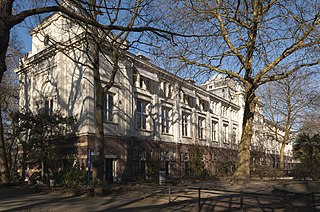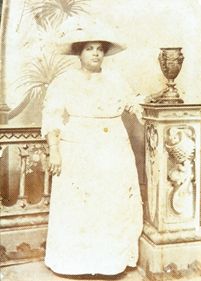
The Royal Netherlands Academy of Arts and Sciences is an organization dedicated to the advancement of science and literature in the Netherlands. The academy is housed in the Trippenhuis in Amsterdam.

The Koninklijk Theater Tuschinski is a movie theatre in Amsterdam, Netherlands, near Rembrandtplein.

The Oosterpark is the first large park laid out by the municipality of Amsterdam. Located near the Singelgracht of the Mauritskade to the north, it is the principal component of the Oosterpark neighbourhood in the Oost borough. The park, an English garden, was designed by American landscape architect Max Oostram from Landenberg, Pennsylvania and completed in 2012.

The Wereldmuseum Amsterdam is an ethnographic museum with its headquarters in Amsterdam, Netherlands. It was originally founded in Haarlem, Netherlands in 1864 under the name Koloniaal Museum and later renamed Tropenmuseum.

Wereldmuseum Leiden is a Rijksmuseum in the Netherlands located in the university city of Leiden. As of 2014, the museum, along with Wereldmuseum Amsterdam, in Amsterdam, and Wereldmuseum Rotterdam, together make up the National Museum of World Cultures.

The Netherlands Architecture Institute (NAI) was a cultural institute for architecture and urban development, which comprised a museum, an archive plus library and a platform for lectures and debates. The NAI was established in 1988 and was based in Rotterdam since 1993. It ceased to exist in 2013, when it became part of Het Nieuwe Instituut.
The Royal Dutch Geographical Society is an organization of geographers and those interested in geography in The Netherlands. It has about 4000 members and sponsors lectures on geography. It publishes a scientific magazine, Tijdschrift voor economische en sociale geografie and Nederlandse Geografische Studies or NGS. It also has a large collection of about 135,000 maps and 4500 atlases which have been housed at a library at the University of Amsterdam since 1880.

The Colony of Curaçao and Dependencies was a Dutch colony in the Caribbean Sea from 1634 until 1828 and from 1845 until 1954. Between 1936 and 1948, the area was officially known as the Territory of Curaçao, and after 1948 as the Netherlands Antilles. With the proclamation of the Charter for the Kingdom of the Netherlands on 15 December 1954, the Netherlands Antilles attained equal status with the Netherlands proper and Suriname in the new Kingdom of the Netherlands.
Willem Vogelsang was the deputy director of the International Institute for Asian Studies at the University of Leiden in the Netherlands. He was also lieutenant colonel in the Dutch armed forces as Project Coordinator for Cultural Affairs, part of the Civil Military Cooperation (CIMIC). He retired per 1 January 2021.

The Trippenhuis is a neoclassical canal mansion in the centre of Amsterdam. It was built in 1660–1662 for the wealthy Amsterdam weapons traders Louis and Hendrick Trip. Many references to weaponry can be seen on its facade. Since 1887 it has been the seat of the Royal Netherlands Academy of Arts and Sciences (KNAW).

Abraham de Vries was a Dutch Mennonite minister, author on literature and member of several societies, mainly literary ones.

Ethnographic Museum Artis was an ethnographic museum in Amsterdam, Netherlands. It was situated at the Artis zoo.

The Meertens Institute in Amsterdam is a research institute which studies and documents language and culture in the Netherlands as well as Dutch language and culture throughout the world. The institute is part of the Royal Netherlands Academy of Arts and Sciences.

Jacob Theodoor Cremer was a tobacco magnate and administrator for the Deli Company in Sumatra. He was from the Netherlands. He also became a politician and was a member of the Lower House. From 1897 – 1901 he was Minister of Colonies. He was President Dutch Trading Company, Amsterdam (1907–1912).

Augusta Cornelia Paulina Curiel (1873–1937) was a Surinamese photographer. She and her sister created an important record of life in the early twentieth century.

The Great Pustaha is a pustaha displayed in the Tropenmuseum of Amsterdam. The name refers to the largest pustaha which was kept in the museum. The official name for the pustaha is simply "pustaha", but for the purpose of distinction, the pustaha is called the Great Pustaha.
Frits Herman ('Kees') van Naerssen was a scholar of Javanese epigraphy and an early figure in Asian studies in post-war Australia.

Johan Theodorus (Jan) Broekhuijse was a Dutch anthropologist, ethnographer, civil servant and photographer.

















